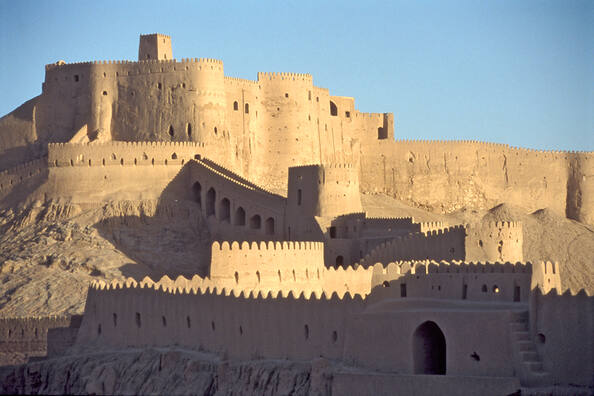Bam y su paisaje cultural
Bam and its Cultural Landscape
Bam is situated in a desert environment on the southern edge of the Iranian high plateau. The origins of Bam can be traced back to the Achaemenid period (6th to 4th centuries BC). Its heyday was from the 7th to 11th centuries, being at the crossroads of important trade routes and known for the production of silk and cotton garments. The existence of life in the oasis was based on the underground irrigation canals, the qanāts, of which Bam has preserved some of the earliest evidence in Iran. Arg-e Bam is the most representative example of a fortified medieval town built in vernacular technique using mud layers (Chineh ).
Description is available under license CC-BY-SA IGO 3.0
Bam et son paysage culturel
Bam et son paysage culturel s’inscrivent dans un environnement désertique, à la lisière sud du haut plateau iranien. On peut retracer les origines de Bam jusqu’à la période achéménide (VIe au IVe siècle av. J.-C.). Située au carrefour d’importantes routes marchandes et réputée pour la production de soie et de vêtements de coton, elle connut son apogée du VIIe au XIe siècle. La vie dans l’oasis reposait sur les canaux d’irrigation souterrains, les qanāts, dont Bam a préservé quelques-uns des plus anciens en Iran. Arg-e Bam est l’exemple le plus représentatif d’une ville médiévale fortifiée construite selon une technique vernaculaire, à l’aide de couches de terre (chineh).
Description is available under license CC-BY-SA IGO 3.0
بام ومشهدها الثقافي
تقع بام ومشهدها الثقافي في بيئة صحراوية على الطرف الجنوبي للهضبة الإيرانية. ويمكن العودة بجذور بام حتى الحقبة الأخيمينية (القرن السادس إلى القرن الرابع ق.م.). وإذ كانت تقع على مفترق طرق تجارية هامة وتعرَف بإنتاج الحرير والملابس القطنية، عرفت أوج ازدهارها من القرن السابع إلى القرن الحادي عشر. وكانت الحياة في الواحة ترتكز على قنوات الريّ الجوفية التي حافظت بام على بعض من أقدمها في إيران. وتشكل "أرق إي بام" مثالاً عن مدينة القرون الوسطى المحصّنة والمبنية حسب تقنية محلية بواسطة طبقات من التربة (الشينة).
source: UNESCO/CPE
Description is available under license CC-BY-SA IGO 3.0
巴姆城及其文化景观
巴姆地处伊朗高原东南边缘的沙漠环境中。它的起源可以追溯到波斯阿赫美尼德王朝(公元前6世纪到公元前4世纪)。巴姆古城地处重要的贸易路线十字路口,以生产丝绸和棉制服装而闻名于世。公元7世纪到公元11世纪时,达到鼎盛时期。沙漠绿洲中生命的存在依赖地下灌溉渠(qanāts),对此,巴姆古城保留了一些伊朗最早的证据。巴姆城堡是使用本地的泥土技术修建中世纪要塞城镇的代表性范例。
source: UNESCO/CPE
Description is available under license CC-BY-SA IGO 3.0
Город Бам и его культурные ландшафты
Город Бам расположен в пустынной местности, на южной оконечности возвышенного Иранского плато. Основание Бама может быть отнесено к периоду власти Ахеменидов, т.е. к VI-IV вв. до н.э. Его наивысший расцвет, пришедшийся на VII-XI вв. н.э., был обусловлен расположением на перекрестке важных торговых путей и производством шелковых и хлопковых изделий. Жизнь в оазисе поддерживалась благодаря подземным оросительным каналам («канатам»), причем каналы Бама являются старейшими в Иране. Цитадель древнего города Арк-э-Бам – это наиболее наглядный пример укрепленного средневекового города, построенного по местным технологиям с использованием глинобитных материалов – «чинех».
source: UNESCO/CPE
Description is available under license CC-BY-SA IGO 3.0
Bam y su paisaje cultural
La ciudad de Bam está situada en una región desértica del extremo sur de la meseta iraní y sus orígenes se remontan al periodo aqueménida (siglos VI al IV a.C.). Situada en una encrucijada de rutas comerciales y reputada por su producción de tejidos de seda y algodón, conoció su máximo apogeo entre los siglos VII y XI d.C. Bam creció en un oasis creado gracias a los qanats, canales de riego subterráneos, de los que ha conservado algunos de los más antiguos de todo el Irán. El sitio comprende la ciudad fortificada medieval de Arg-e-Bam, que es el ejemplo más representativo de conjunto arquitectónico de este tipo construido con una técnica autóctona de apilamiento de capas de adobe (chineh).
source: UNESCO/CPE
Description is available under license CC-BY-SA IGO 3.0
バムとその文化的景観
バムは、イラン高原の南端に広がる砂漠地帯に位置する町。アケメネス朝時代(紀元前6~前4世紀)に始まるバムの全盛期は7~11世紀で、交易ルートの交差路、絹や綿製品の生産地として知られていた。source: NFUAJ
Cultuurlandschap van Bam
Bam ligt in een woestijnomgeving aan de zuidelijke rand van de Iraanse hoogvlakte. Haar oorsprong is terug te voeren naar de Achaemenidische periode (6e tot 4e eeuw voor Christus). De stad beleefde haar hoogtepunt in de 7e tot 11e eeuw – door haar ligging op het kruispunt van belangrijke handelsroutes. Bam stond bekend om de productie van zijden en katoenen kleding. Het leven in de oase was gebaseerd op ondergrondse irrigatiekanalen (qanāts) waarvan in Bam een aantal van de vroegste vondsten bewaard zijn gebleven. Arg-e Bam is het meest representatieve voorbeeld van een versterkte middeleeuwse stad, gebouwd met een inheemse techniek die gebruikmaakte van modderlagen (Chineh). In 2003 verwoestte een aardbeving de stad, de restauratie zal nog jaren in beslag nemen.
Source: unesco.nl
